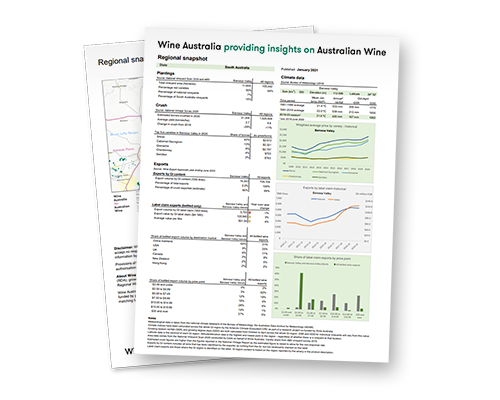The Eden Valley region is located north-east of the city of Adelaide and just east of the Barossa Valley. Overall growing season temperatures are significantly lower than those of the Barossa Valley, and the final stages of ripening and harvesting take place in much cooler conditions.
The GI region is 591 km2 in size and has a total of 2169 hectares of vineyards. The main varieties grown in the region are Riesling, Shiraz, Chardonnay, and Cabernet Sauvignon

Eden Valley Regional Snapshot 2024-25
Regional Snapshots are one-page profiles updated annually of individual Australian wine regions. They provide at-a-glance summary statistics on: climatic characteristics, viticulture data, winegrape production, and winegrape price and export sales data for wine, compared against the same statistics for the whole of Australia.
Download nowCabernet Sauvignon
The Cabernet Sauvignon produced from vineyards around the Eden Valley village is of the highest quality, with perfectly ripened cassis-accented fruit flavours. These contrast with wine from higher, cooler sites that have more elegant undertones of green leaf and dark berry characters.
Chardonnay
Chardonnay is a relative newcomer, with the first commercial vineyards in South Australia being established at Mountadam in 1973. The variety has proved to be highly successful and rich complex wines are being produced; their flavours range through a classic array of melon, fig and cashew.
Riesling
The Eden Valley also has a proud Riesling tradition and is the most important white grape of the region. The wines have strong lime juice aromas with great intensity of flavour on the palate. As the wines age, marmalade and toasty nuances appear on nose and palate. Good Eden Valley Riesling will take ten years or more to reach its peak.
Shiraz
Shiraz ranks as the most important red grape and is often the most highly regarded wine of the region. Contrary to expectations, the wines rarely show the spicy and peppery characters of cool climate Shiraz from other parts of southern Australia. Rather, they tend to more luscious plum and blackberry fruit characters, with touches of liquorice and more gamey, forest characters. Structurally, the wines are very smooth, with ripe tannins that are integrated and well balanced, guaranteeing a long life.

- Altitude, aspect and slope are all important in determining mesoclimate in this hilly region. Therefore, at an altitude of around 500 metres (1640 feet) the Pewsey Vale, Heggies and High Eden vineyards at the southern end of the Eden Valley are considerably cooler than the more northerly Henschke vineyards at an elevation of 380 to 400 metres (1247 to 1312 feet) around Keyneton.
- Overall growing season temperatures are significantly lower than those of the Barossa Valley, and the final stages of ripening and harvesting take place in much cooler conditions.

- Rolling, exposed hills with moderately steep gradients are commonplace and the correct match of site and variety is critical. As one might expect, given the varied terrain, there are a number of soil types. The most common range from grey to brown in colour, and from loamy sand to clay loams. Ironstone gravels, quartz gravels and rock fragments are present in the surface and subsurface.
- These are well suited to dry land viticulture but there are also patches of weaker sandy soils on the slopes, underlain by weathered mica-schists, which have reduced water-holding capacity.
